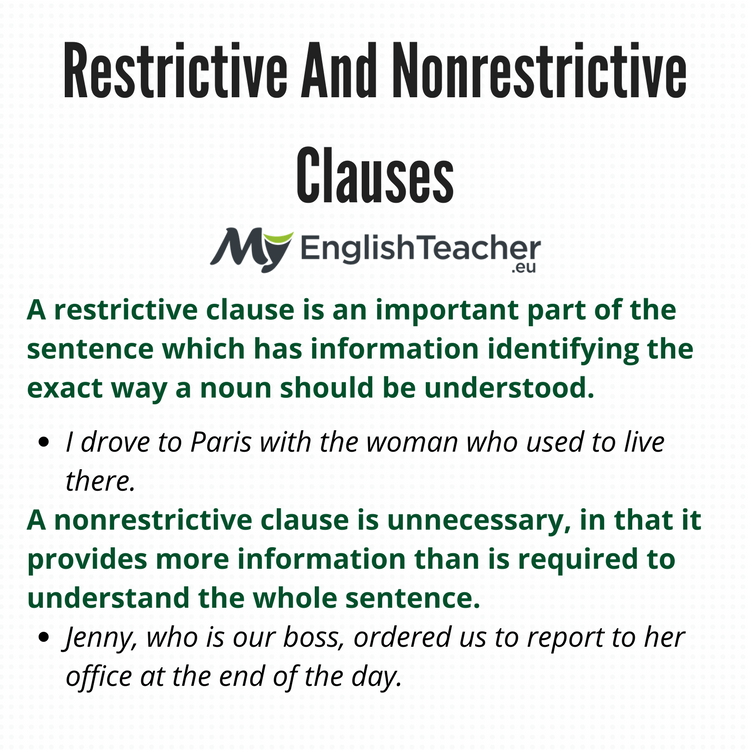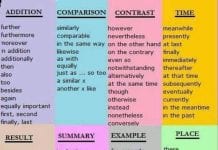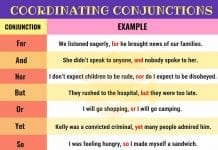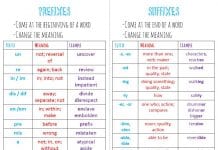
Restrictive and nonrestrictive clauses are very hard for anyone to understand even native speakers! So we will look at what is the difference between restrictive and nonrestrictive clauses in the simplest way we can.
First, we must understand what a clause is.
Clauses
Be careful this word is a noun itself and explained in another post on our website. However, the kind of clause we are speaking about is grammatical.
Almost every sentence has a clause or is a clause. Technically it is a group of words with a verb or subject. Think of it as the part of the sentence you are using to describe the issue or idea about which you are speaking.
Basic Types of Clauses
Main clause:
Every sentence must have a main clause or idea. For example, the main clause of the following sentence is an action.
- My dog loves to run.
Main clauses or sentences of this kind are understandable on their own.
Subjunctive Clauses:
Longer sentences may have many clauses. One clause will be the main clause or idea, while the other will be a subjunctive clause, information that is dependant on the main clause/idea to make sense.
- My dog loves to run but gets hot very quickly.
Subjunctive clauses, secondary information, rely on the main clause to be understood and are not understandable on their own.
Let’s now have a look at what restrictive and nonrestrictive clauses are.
Restrictive And Nonrestrictive Clauses
Restrictive and Nonrestrictive Clauses provides information that relates to the main clause. We form them by combining the following types of clauses:
Relative Clauses:
Relative pronouns such as, who, what, which, when, where, that, are used to begin Relative clauses.
Adjective Clauses
Adjective clauses change a noun or pronoun. They always have a subject and verb. Begin with words like which or that and will answer questions about how many, quantity or some other detail.
Interestingly many see relative and adjective clauses as the same. Although we have separated them, they have very similar meanings.
Because some sentences can be understood in more than one way sometimes, restrictive and nonrestrictive clauses help us understand the exact meaning of the main clause or sentence.
Restrictive(Essential) Clauses
A restrictive clause is an important part of the sentence which has information identifying the exact way a noun should be understood. Restrictive clauses do not use commas usually and removing it would change the meaning of the phrase.
It is essential or necessary to the intended purpose of the sentence, which is why a Restrictive Clause is also known as an Essential clause.
Below are a few examples of restrictive clauses in italics and the reason why we cannot change them.
- I drove to Paris with the woman who used to live there.
- The painting which you spilled water on is a priceless masterpiece.
As we can see, the restrictive clause not only helps to describe the noun but provides valuable information about the noun’s identity.
Nonrestrictive(Nonessential) Clauses
A nonrestrictive clause is unnecessary, in that it provides more information than is required to understand the whole sentence. Commas or even brackets, usually offset the additional information. If we removed a nonrestrictive clause from a sentence, the meaning would not change.
Here are some examples of nonrestrictive clauses.
- Michael Jordan, a famous basketball player, played professional baseball for a few years with a well-known team.
- Jenny, who is our boss, ordered us to report to her office at the end of the day.
Clauses are part of our daily speech, learning correct sentence structure and word order will help you to avoid any confusion about them. However, instead of trying to remember the grammar rules about restrictive and nonrestrictive clauses, just ask yourself this question before speaking.
Is the information necessary for the sentence to be understood correctly or is it just extra information?
The answer will help you determine if it is restrictive or not.
Has this post helped you understand restrictive and nonrestrictive clauses? Tell us with a comment and give us an example if you can think of one.


























